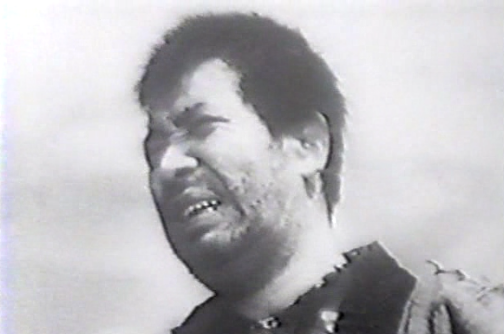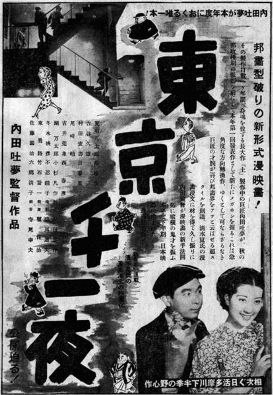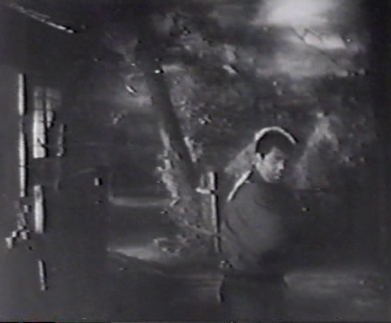Physical Address
304 North Cardinal St.
Dorchester Center, MA 02124

(Continued from Page 1)
The story behind the production of this film has become something of a legend, even more famous, though murkier, than the origin story behind the director’s postwar comeback film, A Bloody Spear at Mount Fuji (Chiyari Fuji, 1955). The accepted myth, as first promulgated by Donald Richie and Joseph L. Anderson in their classic The Japanese Film: Art and Industry (originally published 1959), goes something like the following.1
In 1937, after the release of his prize-winning Unending Advance (Kagirinaki zenshin), Uchida approaches his studio, Nikkatsu, with the idea of adapting to the screen Tsuchi, Nagatsuka Takashi’s classic 1912 novel about dirt-poor Meiji-era farmers. The executives turn him down flat. Undeterred, the stubborn director goes rogue and, with the connivance of sympathetic studio technicians and other personnel, proceeds to film this difficult project without authorization, shooting on location on weekends while simultaneously engaged in other, studio-sanctioned projects during the week.
Somewhere along the line, the studio finally catches on to the deception. But Uchida has gone so far and there are so many people involved that it would entail a major loss of face – not to mention a lot of angry employees – if the studio cancels the production. With great reluctance, Nikkatsu allows Uchida to finish the movie. When it’s finally released in April, 1939, the film becomes a surprise critical and commercial hit.
As far as I can tell, the above is a fairy tale… but one that’s not that far from the truth. A more plausible story can be found on the Japanese Wikipedia page for the novel and film (translation here), which cites a passage from a book that has never, apparently, been translated into English and which therefore I haven’t read: Tanaka Junichirō’s History of Japanese Film Development, Vol. III (pages 29-32). According to Tanaka, Nikkatsu did, in fact, greenlight the Earth project, with an executive named Fukuda Eisaburō overseeing the production, centered at Tokyo’s Tamagawa Studios. But completing it took longer than expected because of the difficulty of location shooting, as the director’s intent was to capture on film all four seasons of rural Japan.
In 1938, Nikkatsu’s head of production, Negishi Kanichi, abruptly left to take over the Manchukuo Film Association in Japanese-occupied Manchuria, known as Man’ei. (Seven years later, near the end of the war, Uchida himself would go to work at Man’ei: see A Biography). Either shortly before or after this change of personnel, the plug was pulled on the production of Earth, with the studio citing as their rationale the production’s cost overruns as well as the film’s presumed lack of commercial appeal.

It was at that point, not earlier, that Uchida chose to defy the studio. Nikkatsu’s budget for Earth had been shut down: technically, Uchida couldn’t spend any more money on it. But in the meantime, Uchida had been assigned to direct the light comedy A Thousand and One Nights in Tokyo (Tōkyō sen’ichi-ya, 1938, lost). Without, of course, any official authorization, he apparently “redirected” some of the funds earmarked for this project (which starred Miake Bontarō, who also appears in Earth) to the clandestine production of the “canceled” film.
It’s not clear when the studio found out about this situation, but for its own reasons, they allowed filming to be completed in early 1939, and the finished product was released in Tokyo’s Teitoza Theater on April 13th, to great acclaim. Its critical reputation remained very high for many years: on the Japanese Wikipedia page about the film, it’s mentioned that in 1959, in a critics’ list of the ten best Japanese productions of the previous 60 years, Earth placed fourth.
Uchida’s obstinacy in carrying this movie to completion against the will of his own studio demonstrates more clearly than any other evidence I’ve found (well, almost any other evidence: see his final film, Swords of Death) his total dedication to his art.
Nagatsuka Takashi’s novel, upon which this film was based, has been published in the United States under the title The Soil (translated by Ann Waswo). Thus, for convenience sake, I will refer to the original novel as The Soil and to the film itself under its usual English title, Earth. In Japanese, the novel and the film share the same title: Tsuchi (土).2
The characters in the film, as in the book, are thinly disguised versions of actual people from author Nagatsuka’s home village of Kosshō (now part of Jōsō city).3 The main family depicted in the book (and thus in the film as well) was a peasant family the novelist had known personally, though all the names were changed. The character of the landlord’s wife, who is called only by the honorific “okamisan” (“madam”) and is never named – and who in the film receives Kanji like a queen on a rustic throne – was based on the novelist’s own mother.
As for the peasant woman who had served as the real-life model for Otsugi, according to Ann Waswo, the novel’s English translator, she survived until 1978.4 She thus outlived novelist Nagatsuka by many decades, and even survived by eight years the director who immortalized her family’s struggles on celluloid.
My comments below refer to the 93-minute German print of the film, which is available on YouTube. For the MOMA screening of the film, which I attended during the museum’s Fall 2016 Uchida Retrospective, the program notes indicated that the programmers had intended to show the 115-minute Russian version of the film discovered in 2006. But apparently this wasn’t the case, as that version should have included the first reel missing from the German version, and I didn’t view that first reel during the screening, nor in fact any scenes that were absent from the German version, with which I’m by now quite familiar. And I have also never seen the 117-minute composite version (that is, the one that combines the German and Russian versions), stored at the National Film Archive of Japan (NFAJ).
The German version of the film (and possibly the longer Russian version as well) were derived, according to Japanese Wikipedia, from a print shown at the 1939 Venice Film Festival, where Uchida’s film was entered in competition for Best Foreign Film but didn’t win. Perhaps the reason that the running times of the versions that now exist are considerably shorter than Uchida’s original two-hour-twenty-two-minute cut is because Uchida himself (or someone at Nikkatsu) extensively edited a print of the film for this particular festival screening.
This practice, by the way, is by no means unusual for long Japanese films shown at foreign festivals. According to this website, because of time limits imposed by officials at the Cannes Film Festival, the version of Kobayashi Masaki’s 183-minute classic, Kwaidan (Kaidan, 1964), when originally shown at that festival, had the film’s entire second episode, “The Woman in the Snow,” cut out of the print to bring the length down to just over two hours. (The full version has, of course, since been restored for home video.) And after a drastically-edited version of Seven Samurai was screened at the 1954 Venice Film Festival, its director, Kurosawa Akira, joked that that version should have been called “Three-and-a-Half Samurai,” because it was so truncated.5
“My approach has changed a lot, but, even today, I still want to present life simply and without detours. This is also why Earth was so hard to shoot.” – Uchida Tomu, undated quote6
Earth is, in my opinion, one of the three most important films Uchida Tomu ever made; the other two are Hero of the Red-Light District (1960) and A Fugitive from the Past (1965). These three movies are so utterly different in style and tone, not to mention subject matter, that they suggest the work of three completely different directors. It is interesting that, of these three works, only Hero of the Red-Light District still exists in more-or-less the form its creator intended.
Earth was certainly the most acclaimed of all Uchida’s prewar movies, and perhaps his most commercially successful. The year in which it finally came out after nearly two years in production, 1939 – which was, of course, an outstanding year for world cinema – was also an exceptional one for Japanese cinema. That year saw the release of Mizoguchi Kenji’s classic The Story of the Last Chrysanthemum; Shimizu Hiroshi’s The Four Seasons of Children, a vision of rural life much sunnier (in every sense) than Uchida’s; the urban drama Warm Current, which established the career of director Yoshimura Kōzaburō, who would go on to become a major postwar filmmaker; Old Songs, Ishida Tamizō’s intriguing portrait of life among the merchant and samurai classes at the dawn of the Meiji era; and Naruse Mikio’s bleak but moving family drama, The Whole Family Works.
Yet it was Uchida’s movie that in 1940 won the top prize – the “Best One” – in the prestigious Kinema Junpo (KJ) critics’ poll for films released in 1939. The film was also highly recommended by the Ministry of Education, as close as anyone at that time could get to an official government seal of approval. And most importantly, for Uchida and for the studio, it was a surprise box office hit.
But despite all this success, if it wasn’t for two incomplete and badly-damaged prints recovered from European film archives, this masterpiece (a word I don’t use lightly) would have been lost forever. As with other prewar Uchida films, the negative and other prints may have been destroyed or misplaced during the chaos of the subsequent World War. The film’s near-disappearance is particularly unfortunate, given the amazing story of its difficult birth (see Production Notes above).
The style of this remarkable work has been said to be strongly influenced by both German Expressionism and Soviet montage theory, which seems to me a justified claim.7 But I think it also strangely prefigures two seemingly incompatible postwar genres: the Italian Neorealist film and American film noir (the latter itself influenced by both German Expressionism and French Poetic Realism).

The location photography by Midorikawa Michio, shot in the actual rural areas in which the author of The Soil grew up, evokes the postwar work of such Italian masters as Luchino Visconti (La Terra Trema, 1948) and Giuseppe De Santis (Bitter Rice (Riso Amaro), 1949). On the other hand, its exceedingly dark visual palette, particularly for the interior scenes, recalls any number of brooding melodramas from 1940s Hollywood.

This “double style” is perfectly appropriate to the movie’s content, because Earth is both an anthropological study of a typical farming community during the Meiji era and a dark portrait of the mind and soul of a neurotic peasant, Kanji, who is driven to near self-destruction by his obsessive hatred for his father-in-law. (This makes the film a good example of Uchida’s recurring theme of the Bonded Adversaries, which I have discussed in the Introduction to this website.) Because of his perverse actions, Kanji is doubly marginalized: he’s both a near-destitute peasant in a harsh and unforgiving environment, and a pariah within his own isolated community.
(Continued on Page 3)
[…] adaptation of Nagatsuka Takashi’s novel The Soil, though he wasn’t cast in Uchida’s 1939 film version. After making his movie debut in 1936, he amassed over 250 film and TV credits over six decades. […]
[…] Uchida's Earth (土), his 1939 masterpiece Aug 2, 2021 / 12:21 pm Reply […]
[…] literary adaptation and the first of two Uchida films in three years (the second one was Earth (Tsuchi)) to top the KJ poll. The ultimate origin of this work was a published story by, of all […]